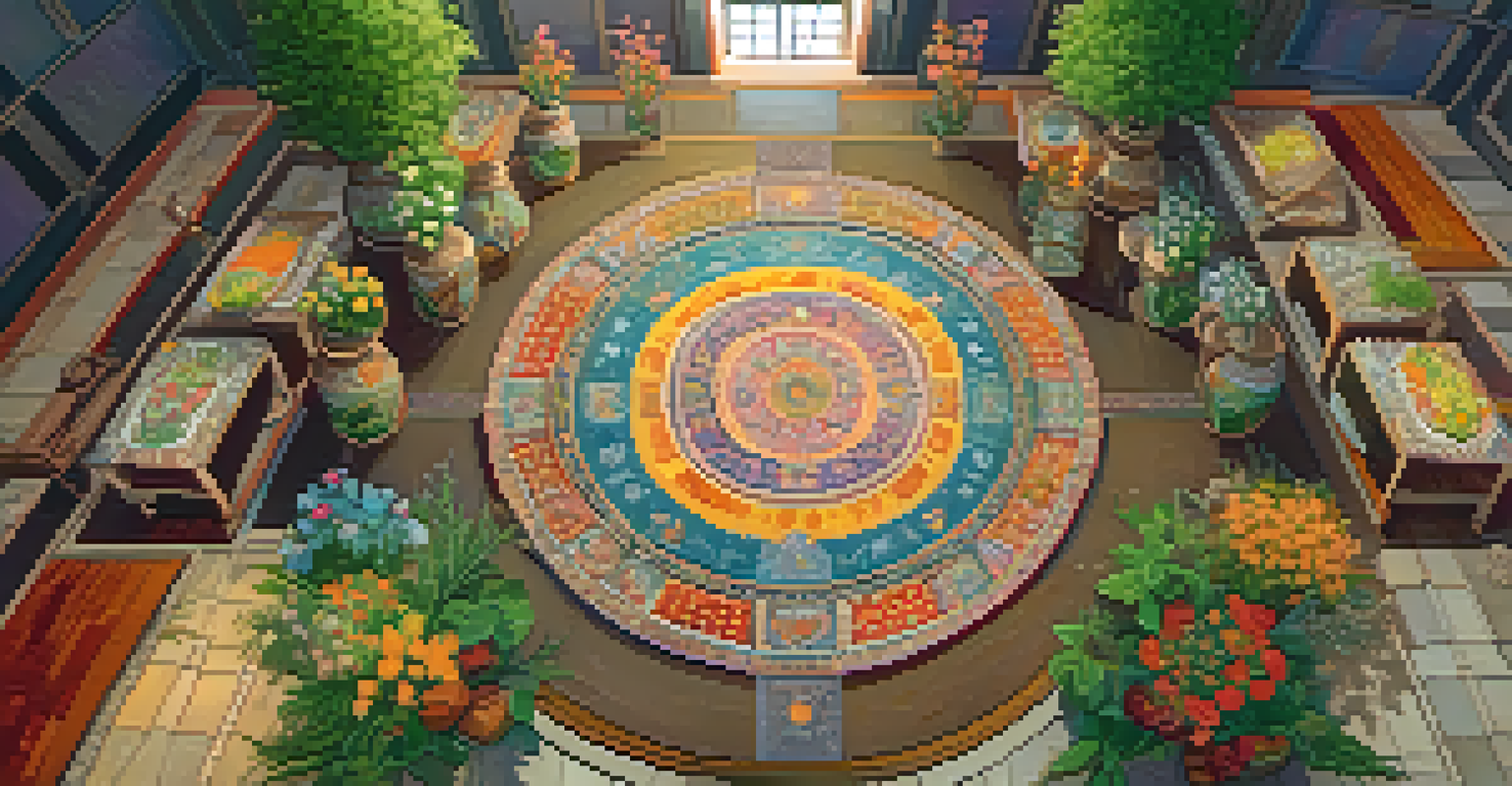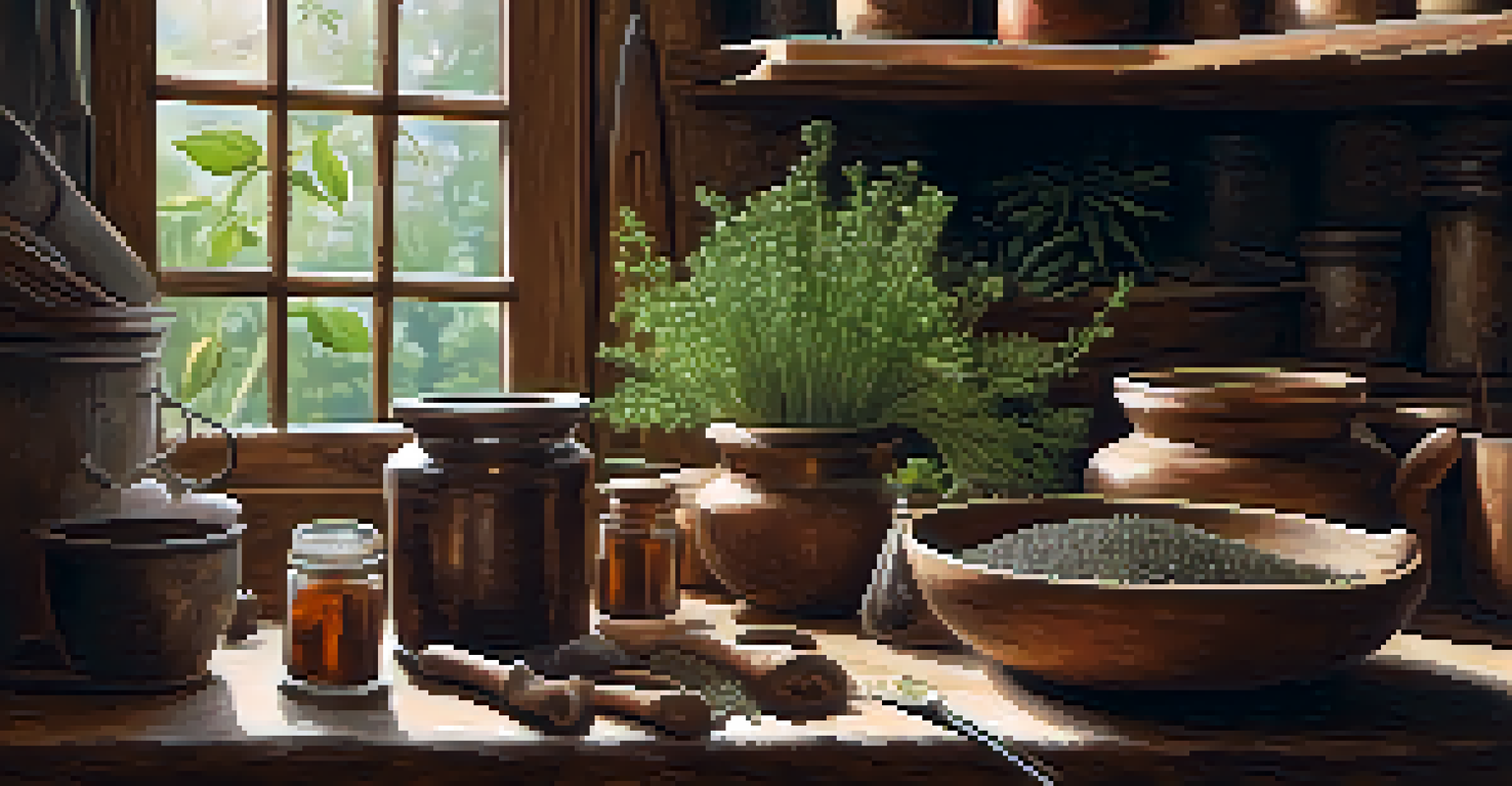Exploring the Intersection of Entheogens and Ritual Practices

Understanding Entheogens: A Brief Overview
Entheogens are substances that can inspire spiritual experiences, often derived from plants or fungi. They have been used for centuries in various cultures to facilitate deeper connections to the divine or to one's inner self. Common examples include psilocybin, found in certain mushrooms, and ayahuasca, a brew from the Amazon. These substances often play a crucial role in rituals aimed at healing, guidance, or enlightenment.
The experience of entheogens is not just about the substance itself; it’s about the intention, the environment, and the community that surrounds it.
In many indigenous cultures, entheogens are not just tools for personal exploration; they are integral to community life. They are often used during ceremonies that mark significant life events or to seek guidance from spiritual entities. This communal aspect strengthens bonds between participants, creating a shared experience that goes beyond individual exploration.
Understanding entheogens requires a shift in perspective from viewing them solely as drugs to seeing them as sacred tools. This perspective encourages respect for the traditions and rituals surrounding their use. It opens up a dialogue about their potential benefits in contemporary spiritual practices, blending ancient wisdom with modern exploration.
Ritual Practices: A Cultural Context
Rituals have been part of human culture since time immemorial, serving various purposes from marking rites of passage to enhancing communal bonds. They often involve structured activities, symbols, and a specific setting that facilitates a deeper connection to the spiritual realm. Whether it's a wedding, a funeral, or a healing ceremony, rituals help individuals and communities navigate life's transitions.

Incorporating entheogens into rituals can amplify the experience, making it more profound for participants. For example, in some South American traditions, ceremonies involving ayahuasca are intended to promote healing and insight, leading to transformative experiences. This combination of structure and substance creates an environment where participants can explore their beliefs and emotions more fully.
Entheogens as Sacred Tools
Entheogens are viewed as sacred substances that facilitate spiritual experiences and community bonding.
Moreover, the role of rituals in providing a framework for using entheogens cannot be overstated. They offer a safe space for individuals to confront their inner fears or seek answers to life's big questions. This structured approach can help mitigate the risks associated with entheogen use, ensuring that experiences are meaningful and beneficial.
The Role of Set and Setting in Experiences
One key principle in the use of entheogens is the concept of 'set and setting'. 'Set' refers to the individual's mindset going into the experience, while 'setting' is the physical and social environment where the experience takes place. Both factors significantly influence the outcome of an entheogenic journey, especially within the context of rituals.
Rituals are the way we make sense of our experiences and give meaning to our lives, especially when exploring the depths of consciousness.
For example, a participant who approaches a ritual with an open mind and positive intentions is more likely to have a beneficial experience. Conversely, anxiety or negative thoughts can lead to challenging experiences, sometimes referred to as 'bad trips'. Thus, the careful preparation of both the mind and environment is crucial for a successful ritual involving entheogens.
Rituals naturally provide a controlled setting that can enhance the overall experience. By creating a sacred space, using intentional music, and engaging in collective practices, participants can immerse themselves in the journey. This mindful approach fosters a sense of safety and community, allowing for deeper exploration and connection.
Entheogens and Healing: A Powerful Connection
The healing potential of entheogens has gained increasing attention in recent years, especially in the context of mental health. Many individuals report transformative experiences that lead to lasting changes in perspective and emotional well-being. In ritual contexts, these substances often serve as catalysts for healing and self-discovery.
Traditional healing ceremonies, particularly among indigenous cultures, often incorporate entheogens as a means to address not just individual ailments but also community issues. Participants may seek guidance from the spirit world or uncover hidden traumas during these rituals, leading to catharsis and communal healing. This holistic approach underscores the importance of context in understanding the effects of entheogens.
Rituals Enhance Healing Potential
Incorporating entheogens into rituals amplifies healing experiences and fosters deeper emotional connections.
Furthermore, modern research is beginning to validate these traditional practices, exploring how entheogens can aid in treating conditions like PTSD, depression, and anxiety. By studying the intersection of spirituality and psychology, we gain insights into how these substances can facilitate deep healing experiences when integrated into ritualistic frameworks.
Cultural Appropriation vs. Cultural Appreciation
As interest in entheogens and their use in rituals has grown, so has the conversation around cultural appropriation versus appreciation. It's important to recognize that many communities have sacred traditions surrounding these substances, which are often tied to their identity and heritage. Engaging with these practices requires not just curiosity but a deep respect for their origins.
Cultural appropriation occurs when elements of a culture are taken out of context, often without permission or understanding. This can lead to the dilution of significant rituals and undermine their value. Therefore, individuals interested in exploring entheogens through ritual should seek to learn from and participate with the cultures that have historically practiced these traditions.
Appreciation, on the other hand, involves honoring and respecting the origins of these practices. This might mean attending workshops led by indigenous practitioners or reading literature that offers insights into their significance. By approaching entheogens mindfully and respectfully, we can foster a more inclusive and authentic exploration of these powerful tools.
Modern Adaptations of Ancient Rituals
In recent years, many have sought to adapt traditional rituals involving entheogens into modern contexts, making them accessible to a wider audience. This trend has led to the creation of new ceremonies that blend ancient practices with contemporary values, such as inclusivity and mental health awareness. However, these adaptations must be approached thoughtfully to avoid losing the essence of the original rituals.
For example, some modern retreats incorporate elements of traditional ceremonies while ensuring participants understand the cultural significance of the practices. This can include educational components that explain the history and purpose of the rituals. By doing so, facilitators can create a respectful environment that honors the roots of these practices while making them relevant today.
Respect Cultural Origins
Understanding the difference between cultural appropriation and appreciation is essential when engaging with entheogenic practices.
Moreover, these modern adaptations can provide valuable insights into the human experience, drawing from both ancient wisdom and current psychological understandings. This synthesis can lead to meaningful experiences that resonate with a broader audience, encouraging a new generation to explore the intersection of spirituality and entheogens.
The Future of Entheogens in Spiritual Practices
As society becomes increasingly open to exploring non-traditional forms of spirituality, the future of entheogens in ritual practices looks promising. With ongoing research and growing public interest, these substances may play a more prominent role in both personal and communal spiritual experiences. This shift could lead to a renaissance of rituals that incorporate entheogens in meaningful ways.
Moreover, as we continue to learn about the benefits and risks associated with entheogen use, there is potential for developing frameworks that ensure safe and respectful practices. This could involve creating guidelines for individuals and communities looking to incorporate these substances into their rituals. Such frameworks would emphasize the importance of consent, education, and cultural respect.

Ultimately, the integration of entheogens into spiritual practices represents a unique opportunity to bridge ancient traditions with modern understandings of consciousness. As we navigate this evolving landscape, it’s essential to approach these practices with curiosity, respect, and an open heart, fostering deeper connections with ourselves, each other, and the world around us.